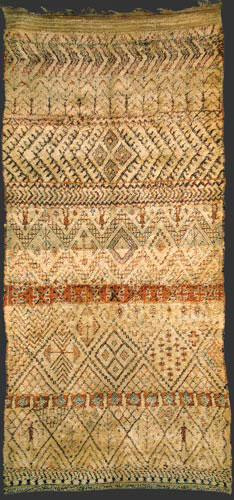WEAVINGS OF THE BENI OUARAIN
AND RELATED MOROCCAN NOMADIC TRIBES
© GEBHART BLAZEK
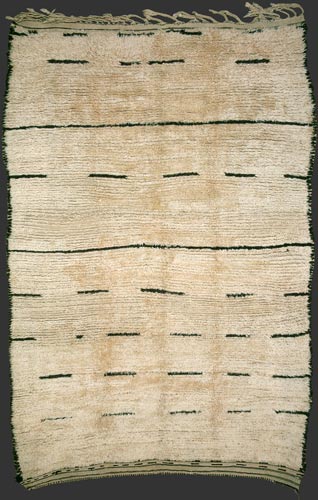 |
|
The Beni Ouarain and some neighbouring Berber tribes in the northeastern Middle Atlas are the weavers of a distinctive type of large, archaic-looking, white-ground pile Berber carpet. These 'white giants' represent a direct link to the earlier weaving traditions of the Zenata Berber, and in their turn have had a fundamental influence on the development of the textiles woven by Morocco's mountain nomads.
|
|
(1) Beni Ouarain rug (Zerarda), ca. 1930, 255 x 175 cm (8' 6'' x 5' 10'') |
|
The Beni Ouarain are a confederation of seventeen Berber tribes (*1), whose ancestors may already have been settled in the most northeasterly part of the Middle Atlas by the 9th century AD. Some trace their origin to the area of southern Tunisia, others to the northernmost part of present-day Mauritania (*2) They speak a Berber language called Ruafa, also known as Zenatiya or Thazighth (*3) Their presentday settlement area is bordered in the south and southeast by the Jebel Bou Iblane Range, and in the north by the Jebel Tazekka, Oued Inaouène and Oued Msoun; there is no such natural border in the west (*4). |
|
The Beni Ouarain heartland has an annual rainfall similar to that of the Rif Mountains, which means that both migratory animal husbandry and settled agriculture are important (2). There have always been settlements built from stone and clay in the valleys (3), and the level of rainfall even allows for some unirrigated agriculture (*5). However, the zone east of the Middle Atlas foothills is so arid that agriculture is possible only along the rivers, as in some areas of southern Morocco. |
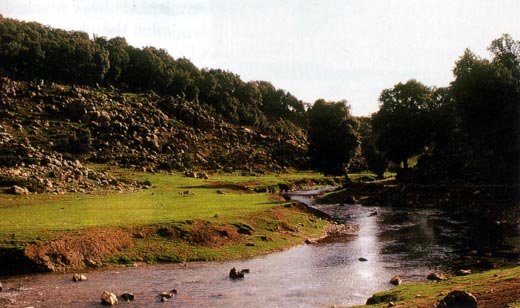 |
| (2) River valley in Ait Abd el Hamid territory |
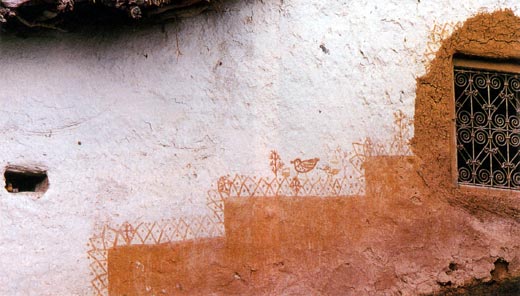 |
| (3) painted decoration on a house in the Ait Abd el Hamid region |
|
One part of each family used to cultivate fields in the valleys, while the others migrated with their flocks and tents to the mountains in summer, descending in winter to the hill country around Tahala or the Guercif Plateau (4) (*6). Since the 1970s, however, the tribes have shown a strong tendency to settle. Cultivators have taken over the good lower grazing ground from the pastoralists, who have begun building permanent homes in the mountains up to a height of around 1,800 metres and are now planting winter cereals even at these heights. In these mountain regions one can nevertheless still find the ancient breed of small sheep whose excellent wool is responsible for the quality of Beni Ouarain rugs and textiles (5). |
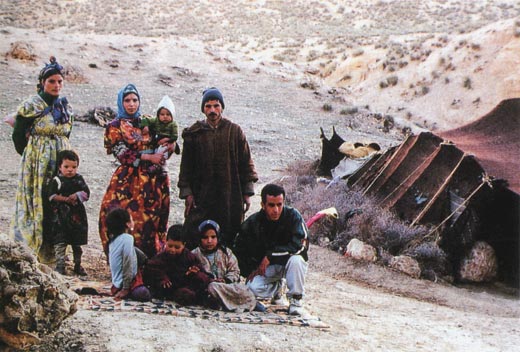 |
| (4) Beni Ouarain (Beni Jelidassen) nomadic family with their tent |
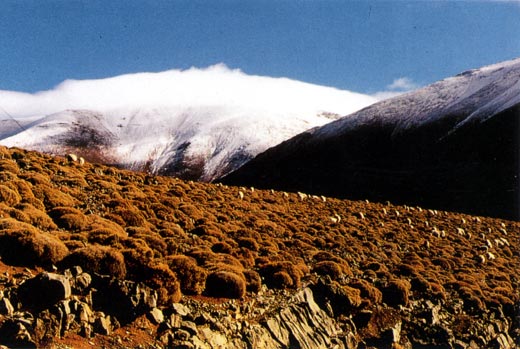 |
| (5) A flock of the old Beni Ouarain breed of sheep grazing at the northern slopes of the Jebel bou Iblane Range. |
The Beni Ouarain pile-weaving tradition may date back as far as the tribe's arrival in their present settlement region around the turn of the last millennium. This suggestion is based on the need for these tribes to produce textiles for protection against winter cold in the highland areas. Until very recently, one group, the Beni bou Zart, continued to make loop-pile textiles called bnchgra which are widely recognized as precursors of pile-woven rugs (*7). The Beni Ouarain flatwoven textile tradition may be even older, since it is possible to establish a clear design relationship with Tunisian textiles, pointing to a common source. The classic Beni Ouarain carpet design has a network of diamonds made up of relatively fine black lines on a white (or cream) ground (6). Borders are uncommon, and even the secondary guard design elements along the sides (7) appear to be the result of external influences. |
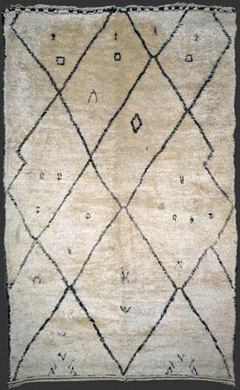 |
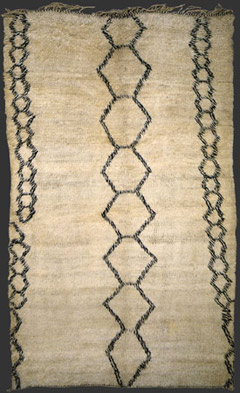 |
|
|
(6) Beni Ouarain carpet (Oulad el Farh), ca. 1940, 355 x 220 cm (11' 10'' x 7' 4'') |
(7) Beni Ouarain rug (Ait Assou), ca. 1960, 300 x 180 cm (10' x 6'), exhibited at the Musée de Marrakech during ICOC, Marrakech 2001 |
|
Because the oldest documented rugs of the Beni Ouarain and of related tribes in the northeastern Middle Atlas have extremely rich designs, one may gain the impression that their creative culture has lost its vigour during the 20th century. The carpets in the Musee Batha in Fez, those in the Musee National des Arts d'Afrique et d'Oceanie in Paris (MAAO), as well as those illustrated by Prosper Ricard and the oldest examples shown here (8, 9), support this impression. But in the course of my field trips I have managed to document a few older fragments with much simpler designs, which suggests the parallel production of both richly decorated and more austere rugs (1, 10). The survival of more of the richly designed pieces may be due to the fact that they were considered more precious, both in their place of origin and by museum curators, and have thus been treated with greater care. |
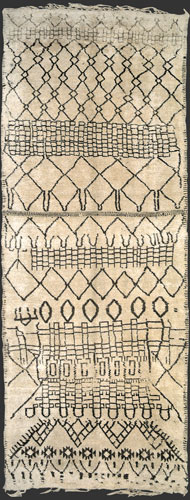 |
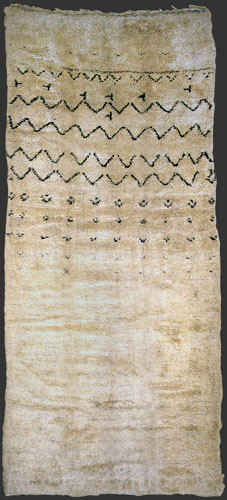 |
|
|
(8) Ait Seghrouchene carpet (western area, south of Fez), ca. 1920, 465 x 180 cm (15' 4'' x 6'), exhibited at the Musée de Marrakech during ICOC, Marrakech 2001 + the Paul Klee Zentrum, Bern, Switzerland, 2009 in the exhibition 'Carpet of Memory' |
(10) Beni Ouarain carpet (Beni bou Zart / Ait Abd el Hamid), ca. 1930, 420 x 190 cm (14' x 6' 4'')
|
|
The warp of Beni Ouarain carpets is always Z-spun natural white wool, as are the wefts, of which there are normally between four and fifteen shoots, but occasionally up to thirty. The pile yarn is Z2S with a pile height of up to 7cm. The Berber knot is the norm, but the Beni bou Zart, Ait Assou, Zerarda and Ait Ighezrane tribes in the west, as well as the Beni Jelîdassen in the southeast, also use the symmetric knot or a mixture of both types. An old and until recently unknown weaving tradition continues in the territory of the Beni Jelîdassen, the southeasternmost tribe of the Beni Ouarain. They practice a semi-nomadic lifestyle that has been unchanged for centuries. They migrate from settlements in the eastern valleys of the north Middle Atlas to mountain pastures in the Jebel bou Iblane and Jebel bou Nsor regions and to the plains in the Moulouya Valley. There they have come into contact with the Marmoucha, whose weaving tradition is clearly reflected in the palette of Beni Jelîdassen pile-woven cushions (11). |
|
|
 |
|
|
(9) Beni Ouarain carpet (Oulad el Farh), ca. 1900, 410 x 210 cm (13' 8'' x 7'), exhibited at the Musée de Marrakech during ICOC, Marrakech 2001
|
(11) Beni Ouarain pillow (Beni Jelîdassen), ca. 1940/50, 160 x 50 cm (5' 4'' x 1' 8''), exhibited at the Musée de Marrakech during ICOC, Marrakech 2001 + the 'beauté sauvage'exhibition at the BA-CA Kunstforum, Vienna, Austria, 2003 |
|
|
The repeated occurrence of the cross motif in Beni Jelîdassen pile weavings is striking, but it remains impossible to explain its symbolic meaning. The motif is sometimes ritually painted in henna on the back of a completed textile when it is taken off the loom (12). Crosses are also painted on the interior walls of living rooms, suggesting a powerful talismanic significance. |
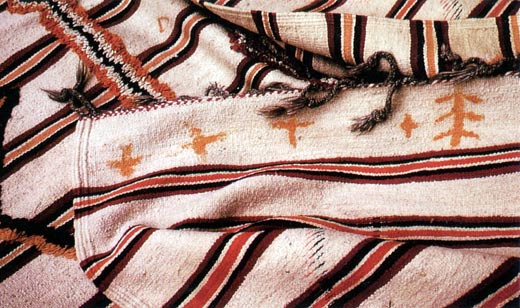 |
|
(12) Beni Jelîdassen semi-nomads from the southeastern Beni Ouarain territory in the Middle Atlas use henna to daub apotropaic symbols such as crosses on the back of flatwoven covers (sachou) when they are taken from the loom. |
|
The cultural and historical significance of Beni Jelîdassen pilewoven cushions lies above all in the likelihood that they belong to a tradition, continuing into the 20th century, closely related to that of the rugs which Ricard, in 1934, dated to the 19th century and attributed to the Marmoucha and (erroneously?) to the Beni M'Guild (*10). Most such cushions look like fragments cut from the rugs published by Ricard. It is very surprising to see such a variety of colours used by a Beni Ouarain tribe; apart from the usual white and black, we find blue, dark red, green, orange and yellow as colours of completely equal weight. The flatweaves of this tribe have a similar polychrome palette, with a significantly high proportion of blue. Black-ground rugs are very rare in the Middle Atlas region. Apart from a Marmoucha piece in the Musee Batha in Fez (*12), we know of only a few Zemmour and Ait Serrouchène examples. The existence of old black-brown shawls from the Beni bou Zart region, a type which for some fifty years has been woven with a white ground, as well as the use of undyed black yarn for the weft of old Marmoucha rugs, suggests that black-ground rugs could have been more common at one time than they later became, perhaps due to a higher proportion of black sheep in the flocks. Among the Beni bou Zart and the Zerarda in particular one can find rugs which abandon the classic diamond scheme for a minimalist design (1, 10). Zerarda pieces are sometimes noticeably smaller, between 2.5 and 3 metres in length (1). It seems justifiable to talk of a separate Zerarda stylistic subgroup, which includes relatively rare pure white carpets. When woven from the excellent silky, shiny wool typical of early Beni Ouarain rugs, these pieces are remarkable for their calm elegance. The Beni Alaham, who do not belong to the Beni Ouarain Confederation, are settled west of the Ail Ighezrane and the Zerarda. Ricard described their rugs (*13), but they have been hardly mentioned in the literature since. Their white-ground rugs are most closely related to those of their eastern neighbours. Clear Beni Alaham characteristics are the S-spun warps and bold, striped kilim ends up to 20cm deep. Both Ricard's description and the pieces in the Musee Batha (*14) indicate that the Beni Alaham preferred smaller scale designs. The piece shown (13) was purchased in the Zerarda region, but the warp spin and the delicately structured centralised field design point to a strong Beni Alaham influence. While the relatively few known pieces of this tribe tend to be very similar, this rug is striking as a result of the weaver's decision to leaven the austere pattern by adding an element of restrained colour and a change in the rhythm of the design. |
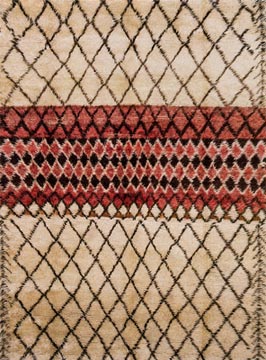 |
(13) Beni Alaham carpet (detail), ca. 1940/50, 420 x 195 cm (14' x 8' 6'') |
|
Another tribe who produced related white-ground rugs are the Ait Seghrouchène. Their present-day settlement region is divided into three sections: one to the west of the northwestern range of the Beni Ouarain; another to the southwest, between the Beni Alaham and the Ait Youssi; and a third north of the Ait Youssi, south of Fez.
Textiles with a similar structure but with rows of design in weft-substitution technique are called abrdouhe. This type is normally made from wool only. A version for everyday wear, similar in technique to the second type, but with a much coarser weave and fewer design elements, is known as tabbnoute. All have pile on the back to a greater or lesser degree. The design threads of the front are either carried on the back in loops to produce a cushion-like pile, or are left hanging loose, up to 15cm long, producing a pelt-like surface. |
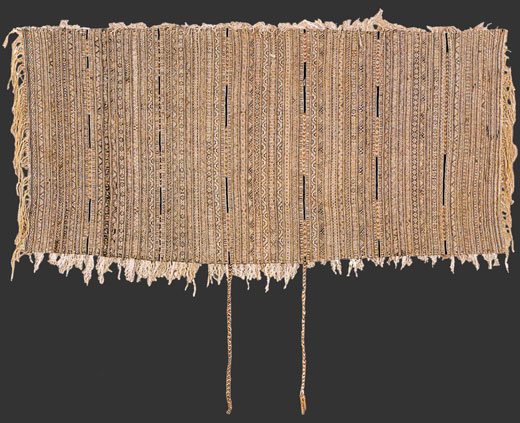 |
|
(14) Beni Ouarain (Oulad Ali / Oulad bou Ali) tabrdouhte (arab.: handira), women's flat-woven ceremonial shawl, ca. 1900, 195 x 95 cm (6' 6'' x 3' 2''), with the typical weft wrapping patterns and the linen strands on the back, coll. L. Viola, Marrakech |
|
Also woven across the entire region are the large bags called sachou, with design elements on the front. The rather rare blankets known as hanbel are identical to these bags and only differ from them in their greater length. Smatt n'ouisse (horse saddlebags) are very rare. They are related to the saddle-bags common in the western Middle Atlas, but in palette they show similarities with Beni Ouarain abrdouhe shawls. The original of this article has been published in HALI , issue 94, London , September 1997. The present version is adapted to today's knowledge in several details. |
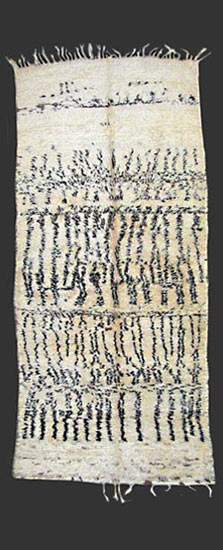 |
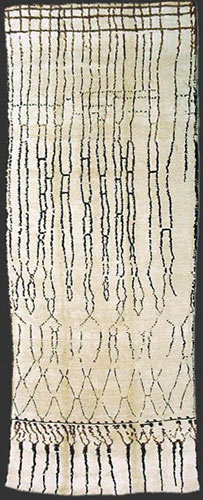 |
|
|
(15) Beni Ouarain carpet (probably Beni bou Zart), ca. 1950, 360 x 160 cm (11' 8'' x 5' 4'') |
(16) Beni Ouarain carpet, ca. 1920/30, 440 x 190 cm (14' 6'' x 6' 4'') |
|
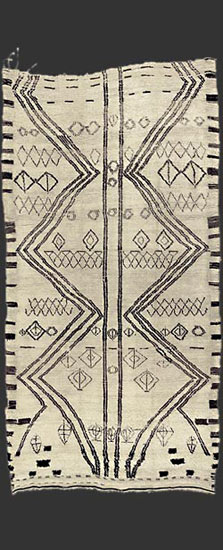 |
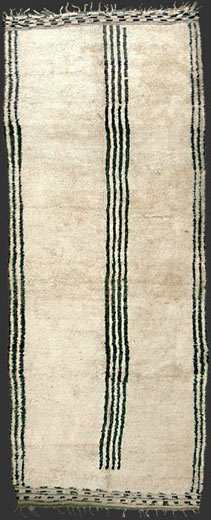 |
|
|
(17) Beni Ouarain carpet (Oulad el Farh), ca. 1920/30, ca. 390 x 200 cm (13' x 6' 8''), exhibited at the Musée de Marrakech at the 'beauté sauvage' exhibition during ICOC, Marrakech 2001 + during the 'beauté sauvage 2' exhibition, 2003 at the BA-CA Kunstforum, Vienna, Austria |
(18) Beni Ouarain carpet (Ait Ighezrane), ca. 1940/50, 460 x 180 cm (15' 4'' x 6')
|
|
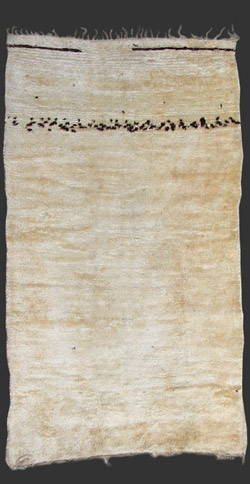 |
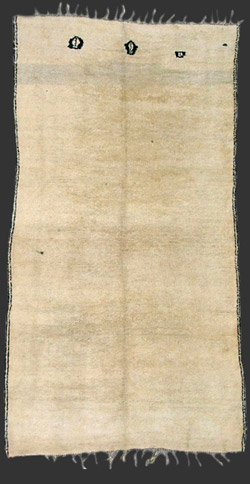 |
|
|
(19) Beni Ouarain carpet (probably Beni bou Zart or Ait Abd el Hamid), ca. 1900/20, 360 x 205 cm (11' 8'' x 6' 10'') |
(20) Beni Ouarain carpet (probably Ait Ighezrane or Oulad el Farh), ca. 1930/40, 330 x 185 cm (10' 10'' x 6' 2'') |
|
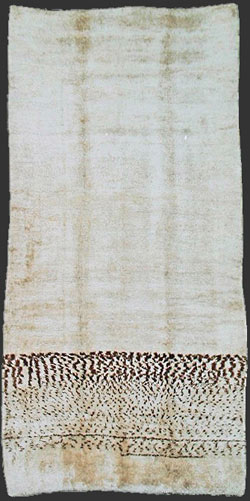 |
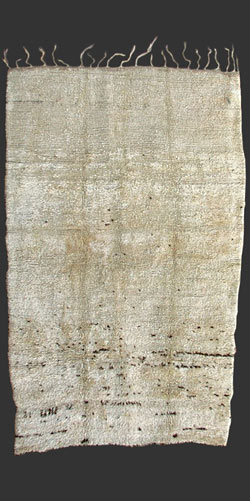 |
|
|
(21) Ait Seghrouchene carpet, ca. 1920, 370 x 180 cm (12' 2'' x 6') |
(22) Beni Ouarain rug, ca. 1920/30, 320 x 200 cm (10' 6'' x 6' 8'') |
|
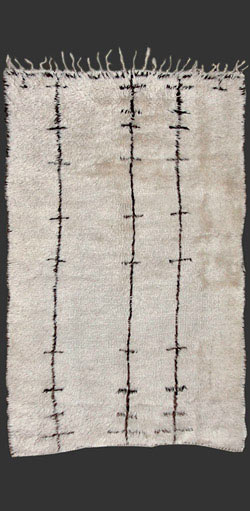 |
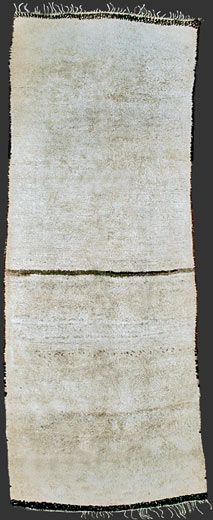 |
|
|
(23) Beni Ouarain rug (Ait Assou or possibly Zerarda), ca. 1940/50, 240 x 145 cm (8' x 4' 10'') |
(24) Beni Ouarain or Ait Seghrouchene carpet, ca. 1950/60, 485 x 190 cm (16' x 6' 4'')
|
|
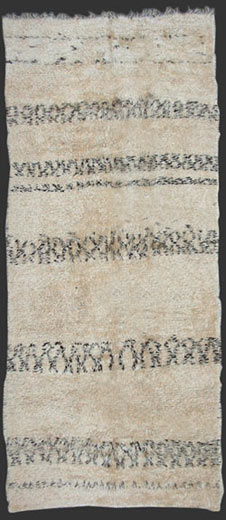 |
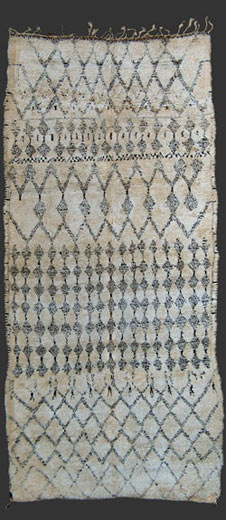 |
|
|
(25) Beni Ouarain carpet (probably Beni bou Zart), ca. 1930, 415 x 175 cm (13' 8'' x 5' 10'') |
(26) Beni Ouarain carpet (probably Imghilen), ca. 1920, 440 x 210 cm (14' 6'' x 7') |
|
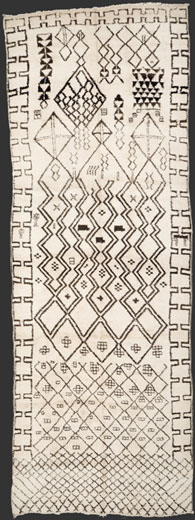 |
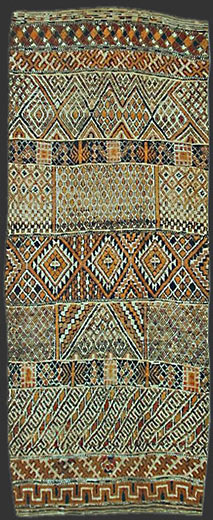 |
|
|
(27) carpet of the Ait Seghrouchene or southern Beni Ouarain (Oulad el Farh), ca. 1930, 535 x 195 cm (17' 6'' x 6' 6'')
|
(28) Beni Ouarain (Oulad el Farh) carpet, ca. 1920, 465 x 195 cm (15' 4'' x 6' 6''). executed with the help of a female master weaver ('maallema'). cf. Prosper Ricard: 'Corpus des Tapis Marocains, tome 4', edition Geuthner, Paris 1934, plate XXXV and XXXiX |
|
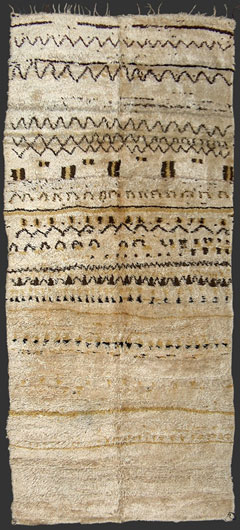 |
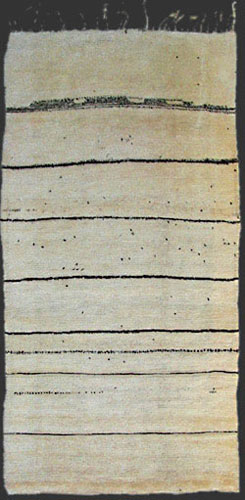 |
|
|
(29) Beni Ouarain carpet (probably Beni bou Zart or Ait Abd el Hamid), ca. 1900/20, 420 x 180 cm (13' 10'' x 6') |
(30) Beni Ouarain carpet, ca. 1920/30, 380 x 200 cm (12' 6'' x 6' 8'')
|
|
|
The original of this article has been published in HALI , issue 94, London , September 1997. |
|
|
Notes M. Messaouidi / W. Stanzer (editors), ICOC catalogue, Casablanca / Lieboch, 1997, lecture Gebhart Blazek: Textiles and Carpets of the Beni Ouarain and their Sub-Tribes: Differences and Differentiations / Les textiles et les tapis des Beni Ouarain et de leurs sous-groupes: différences et délimitations / Textilien und Teppiche der Beni Ouarain und deren Untergruppen: Unterscheidungen und Abgrenzungen *8. Marcy, op.cit., pp.102-103. A correct transcription of the tribal confederation's name is Beni Ouarain ( neither Beni Ourain, nor Beni Quarain are correctly or commonly used terms). The tamazight language term 'Ait Ouarain' appears in literature of the period of the French protectorate but is not remembered in the region to have been commonly used in the 20th century. In German the transcription Beni Warain is also commonly used. further bilbliography: Prosper Ricard: Prosper Ricard / Marcel Vicaire: „Corpus des Tapis Marocains“, tome 5 / fascicule1, Rabat 1950 Wilfried Stanzer: Berber / Stammesteppiche und Textilien aus dem Königreich Marokko, Graz 1991, S. 96 ff, Beni Warain / Beni Ouarain Teppich M. Messaouidi / W. Stanzer (editors), ICOC catalogue, Casablanca / Lieboch, 1997, lecture Gebhart Blazek: Textiles and Carpets of the Beni Ouarain and their Sub-Tribes: Differences and Differentiations / Les textiles et les tapis des Beni Ouarain et de leurs sous-groupes: différences et délimitations / Textilien und Teppiche der Beni Ouarain und deren Untergruppen: Unterscheidungen und Abgrenzungen Kurt Rainer: Marokko mon amour / Morocco mon amour, Graz 2005 Rachel Hasson / Gebhart Blazek: Moroccan Charm, Art of the Berber Tribes, Jerusalem 2005 |
|
|
|
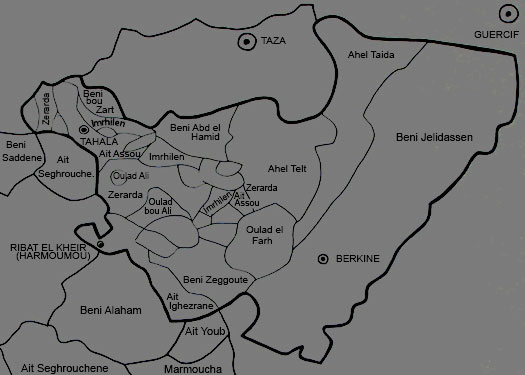 |
|
|
map of the Beni Ouarain territory © Gebhart Blazek |
|
| Wikipedia: Berber carpet |



